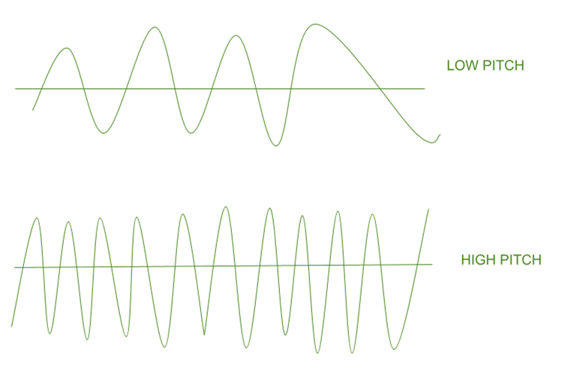音高和响度
人们在日常生活中会遇到各种形式的声音,每个人都有一套系统来识别声音模式中的各种差异。当母亲对她的孩子说话时,她的口音与孩子的口音不同。所有这些变化都是由于一种称为声音的音高和响度的机制,它总是将一个人的声音与另一个人的声音区分开来。这就是为什么您的声音在您的整个班级、家庭和地区如此独特的原因。然而,与另一个或模仿非常相似的声音也属于这种现象。让我们看看声音的响度,声音的音高,以及两者的区别。
在讨论声音的响度和音高的概念之前,我们先简单了解一下声音的基本特征。这对理解声音的响度和音高有很大帮助。
声音的特点
人们可以听到日常生活中的各种声音,例如哭声、大喊声和笑声,而且不仅限于人。动物也会发出声音,但它们与人类的声音不同。鼓的声音和长笛的声音相似吗?那么,两者有什么区别呢?让我们看一下声音的一些基本属性来理解这一点。
声波有四个主要特征,下面简要解释如下:
- 振幅:电磁波中的能量大小称为光的振幅。波从其平均点的最大垂直位移称为振幅。能量越高,振幅越大。幅度的 SI 测量单位是米 (m),尽管有时它也以厘米为单位。

幅度和波长
- 波长:波长是声波重复自身的最短距离。换句话说,单个全波的持续时间称为波长。一个希腊字母用来表示它,λ (lambda)。米是测量波长 (m) 的 SI 单位。
- 频率:创建单个全波、周期或周期所花费的时间称为波的时间段。振动体的一个最大脉冲现在产生一个总波。因此,完成一次振动所花费的时间称为时间段。字母 T 代表它。秒(s)是时间段的单位。

- 时间周期:波的频率定义为一秒内产生的全波或周期数。每秒的波数称为频率,因为振动体的一个最大脉冲会产生一个总波。赫兹或赫兹是频率的国际单位制单位。振动体每秒发射一波的频率为 1 赫兹。换句话说,1 Hz 等于每秒 1 个脉冲。
声音的响度

在产生声音时所施加的能被到达的耳朵测量的能量的大小称为声音的响度。它也可以称为耳朵对声音的反应。声音的响度取决于它的幅度。如果振动的幅度很大,产生的声音也会很大。而当幅度较小时,产生的声音也会很微弱。以下是与声音响度相关的要点:
- 声音的响度是每秒到达耳朵的声能的量度。
- 声音的响度与振动幅度的平方成正比。那是,
响度∝(幅度) 2
例:如果振幅变为两倍,响度将变为 4 倍。
- 响度的特性是区分相同频率和音高的两种声音的能力。声波的大小和幅度决定了声音的强度。
- 响度用称为分贝 (dB) 的单位表示。超过 80 dB 的声音会变成噪音,这就是为什么婴儿比成人对大声噪音更敏感的原因。
- 下表提供了对来自不同来源的声音响度的差异比较。
Source | Amount of Loudness |
Normal breathing | 10 dB |
Factory | 80 dB |
Mellow whisper (at 5 m) | 30 dB |
Basic conversation | 60 dB |
High traffic | 70 dB |
音高

音高通过确定其频率范围来定义声音的质量。它也被称为尖锐度。如果振动频率更高,则意味着声音更刺耳。但是如果声音是低频的,我们会认为声音的音调很低。例如,可以注意到女人的声音比男人的声音高。以下是与声音音高相关的要点:
- 这是由波的振动幅度决定的。
- 如果振动频率较大,则声音尖锐并具有尖锐的音调。
- 当一个声音被称为具有较低的音调时,这意味着它以较低的频率振动。鸟儿发出高亢的声音,而狮子的尖叫声是低沉的。
- 人耳可以听到 20 Hz 到 20 kHz 的声音。
- 由于音高的不同,不同的物种和物体会发出不同的声音:
Source | Pitch |
Man | Low |
Woman | High |
Tabla | Low |
Birds | High |
Tiger | Low |
音高和响度之间的区别
Pitch | Loudness |
| Pitch is the feature of sound that distinguishes a shrill sound from a grave or flat sound. | Loudness is a sound quality that allows a noisy sound to be separated from a faint one. |
| The amount of energy received by the ear has no bearing on the pitch. | The sum of sound energy produced by the ear in unit time determines the volume of the sound; the more energy received, the louder the sound. |
| Pitch is independent of energy exerted. | Loudness is independent of frequency. |
| Mathematically, the pitch is proportional to the frequency of the sound | Mathematically, loudness is directly proportional to the square of the amplitude. |
| The pitch can be measured in Hertz (Hz). | The loudness can be measured in Decibel (dB). |
| The phenomenon by which shrillness and soft or polite sound differs is called the pitch of that sound. | The phenomenon by which normal breathing and busy traffic differ is called the loudness of that sound. |
示例问题
问题1:如果波的振幅加倍,它的响度会怎样?
解决方案:
Since, it is known that, Loudness α (Amplitude)2.
Therefore, if amplitude is doubled then the loudness becomes 4 times.
问题2:音乐声音的特点是什么?
解决方案:
The three characteristics of a musical sound are:
Loudness, Pitch and Quality.
问题3:为什么弹拨线安装在音板上时听到的声音响度增加?
解决方案:
When a wire mounted on a sound board is plucked, the surface area of vibrating air increases and sends greater amount of energy. So the amplitude of vibration is large and louder is the sound heard.
问题 4:陈述听者听到的声音响度取决于的三个因素?
解决方案:
The various factors on which loudness of sound heard by a listener depends are:
- Amplitude of wave,
- Distance of source of sound,
- Surface area of vibrating body,
- Sensitivity of listener and
- Intensity of sound.
问题 5:命名并定义使人能够区分同一乐器给出的两种响度相同但频率不同的声音的特征。
解决方案:
The characteristic which enables one to distinguish two sounds of same loudness, but of different frequencies, given by the same instrument is pitch. The sensation of a frequency is commonly referred to as the pitch of a sound. A high pitch sound corresponds to a high frequency and a low pitch sound refers to a low frequency sound wave.